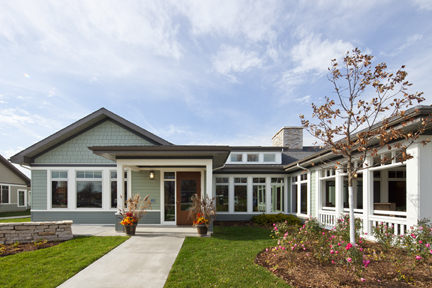The Chicago office of Perkins Eastman joins the U.S. Department of Veteran Affairs (VA) in announcing the country’s first Community Living Center (CLC) to utilize the Green House Prototype Design Package at the VA Illiana Health Care System campus in Danville, Ill.
The CLC at Danville consists of two 7,500 sf buildings—named Freedom House and Liberty House—containing ten private bedrooms with direct views to common areas, communal living areas and kitchens, and ample outdoor space, all with an aim to restore maximum function and independence while providing veteran-centered care.
The VA Illiana Health Care System CLC is the first of several VA communities either planned or under construction that utilizes the Green House Prototype Design Package, a new approach for seniors needing skilled nursing care that emphasizes de-institutionalization. The prototype was designed in 2011 by Perkins Eastman in concert with the Green House Project and NCB Capital Impact to provide a turnkey design for senior living communities at a reduced schedule and with reduced costs. The overall goal of design is to empower more providers across the country to create communities where seniors can experience quality care in a de-institutionalized environment.
A transformation in the way veteran care is delivered, Freedom House and Liberty House address the spectrum of health—physical, emotional, psychological—in their design. In adopting this community-based model of care, Freedom House and Liberty House at VA Illiana provide greater assurances of privacy and personalized environments for veterans in ways more traditional models cannot.
Perkins Eastman also designed six CLC buildings at the Captain James A. Lovell Federal Health Center in North Chicago, Ill., the first phase of which consists of two Green House Prototype buildings currently under construction to complete this summer. The second phase consists of four CLC buildings currently in design. BD+C
Related Stories
Architects | Jul 23, 2015
CTBUH recognizes Parkroyal on Pickering as Urban Habitat Award winner
The Singapore hotel has green space galore
Sports and Recreational Facilities | Jul 23, 2015
Japan announces new plan for Olympic Stadium
The country moves on from Zaha Hadid Architects, creators of the original stadium design scrapped last week.
Green | Jul 23, 2015
NASA: U.S. headed for worst droughts in a millennium
Data from NASA shows carbon emissions could be the driving force behind devastating water shortages and record droughts in the western U.S.
Airports | Jul 22, 2015
MUST SEE: JFK airport taps Gensler to design terminal for animals
Pets can enjoy luxurious spa and grooming services before being transported directly to their flight from the terminal.
Office Buildings | Jul 21, 2015
Finally! There's a workplace trend that’s worth embracing
There’s a realization by corporate real estate executives that in order to create a successful workplace, there must be alignment between their people, their place, and the tools they have to do their jobs.
University Buildings | Jul 21, 2015
Maker spaces: Designing places to test, break, and rebuild
Gensler's Kenneth Fisher and Keller Roughton highlight recent maker space projects at MIT and the University of Nebraska that provide just the right mix of equipment, tools, spaces, and disciplines to spark innovation.
Architects | Jul 21, 2015
Architecture Billings Index at highest mark since 2007
This is the first month in 2015 that all regions are reporting positive business conditions, said AIA Chief Economist Kermit Baker.
BIM and Information Technology | Jul 20, 2015
New stylus brings digital sketching to the next level
Without buttons, users can change the weight of the stylus’ stroke.
Architects | Jul 20, 2015
New York design competition looks to shed the sidewalk shed
New York, which has nearly 200 total miles of sidewalk sheds, is seeking a concept that is practical but that also looks good.
Cultural Facilities | Jul 19, 2015
SET Architects wins design competition for Holocaust Memorial
The design for the memorial in Bologna, Italy, is dominated by two large metal monolithic structures that represent the oppressive wooden bunks in concentration camps in Germany during World War II.

















